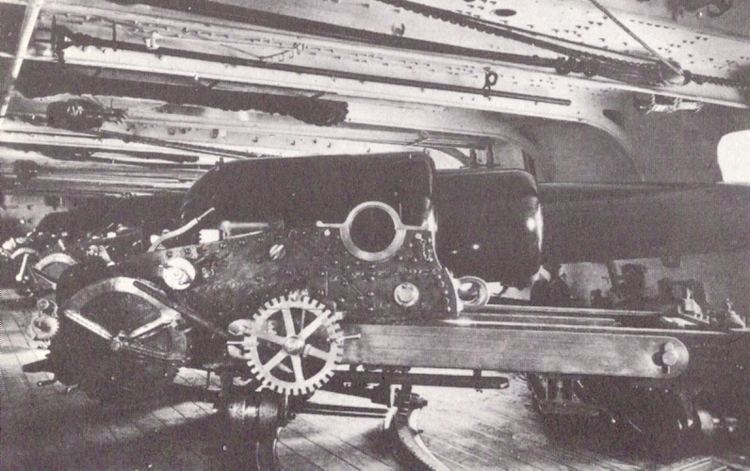Type Naval gun
Coastal gun In service 1868 - 19?? | Place of origin United Kingdom | |
 | ||
Used by Royal Navy
Australian Colonies Wars Bombardment of Alexandria (1882) Designer M Robert Fraser, Royal Gun Factory | ||
The RML 10 inch guns Mk I - Mk II were large rifled muzzle-loading guns designed for British battleships and monitors in the 1860s to 1880s. They were also fitted to the Bouncer and Ant-class flat-iron gunboats.
Contents
Design
The 10-inch gun was a standard "Woolwich" design (characterised by having a steel A tube with relatively few broad, rounded and shallow rifling grooves) developed in 1868, based on the successful Mk III 9-inch gun, itself based on the "Fraser" system. The Fraser system was an economy measure applied to the successful Armstrong design for heavy muzzle-loaders, which were expensive to produce. It retained the Armstrong steel barrel surrounded by wrought-iron coils under tension, but replaced the multiple thin wrought-iron coils shrunk around it by a single larger coil (10 inch Mark I) or 2 coils (Mark II); the trunnion ring was now welded to other coils; and it eliminated Armstrong's expensive forged breech-piece.
The gun was rifled with 7 grooves, increasing from 1 turn in 100 calibres to 1 in 40.
It was first used for the main armament on the central battery ironclad HMS Hercules, completed in late 1868.
A number of the Mk I guns on HMS Hercules and one of the two damaged guns in HMVS Cerberus suffered from cracked barrels. Presumably this is why only a few (at least 25) Mk I guns were made.
Ammunition
When the gun was first introduced projectiles had several rows of "studs" which engaged with the gun's rifling to impart spin. Sometime after 1878, "attached gas-checks" were fitted to the bases of the studded shells, reducing wear on the guns and improving their range and accuracy. Subsequently, "automatic gas-checks" were developed which could rotate shells, allowing the deployment of a new range of studless ammunition. Thus, any particular gun potentially operated with a mix of studded and studless ammunition.
The gun's primary projectile was "Palliser" shot or shell, an early armour-piercing projectile for attacking armoured warships. A large "battering charge" of 70 pounds "P" (pebble) or 60 pounds "R.L.G." (rifle large grain) gunpowder was used for the Palliser projectile to achieve maximum velocity and hence penetrating capability.
Common (i.e. ordinary explosive) shells and shrapnel shells were fired with the standard "full service charge" of 44 pounds "P" or 40 pounds R.L.G. gunpowder, as for these velocity was not as important.
Surviving examples
One 10 inch Mk I Common Shell, one 10 inch Mk II Common Shell & one 10 inch Mk III Palliser Shot as part of the Victorian Navy display at the Geelong Maritime Museum, Australia. Details
Various other guns are mounted or unmounted in Bermuda, with some lying outside of Fort St Catherine, having been rolled out when made obsolete (the guns actually mounted on display there were taken from other forts, notably Fort Albert), and a number having been found buried in the moat of Fort Cunningham (the two mounted at Fort George are the RML 11 inch 25 ton gun). At least one has been erected on a display stand at Fort Hamilton, though the original mount is missing, and another at Alexandia Battery.
